#High-dynamic-range rendering
Explore tagged Tumblr posts
Text
Sims 4 Render Lighting Tutorial

"Environmental Lighting" won my most recent poll, so let's get right into it!
A few notes before we begin:
I render exclusively in cycles!
This tutorial assumes some basic knowledge of blender
Though this tutorial covers the basics, HDRIs can be used in conjunction with any scene/your built scenes
I decided to focus on environmental and other lighting in this tutorial, since they all kind of go hand in hand.
For this tutorial, I'll be using my recent Cupid Sim. Here's a render of her with no additional lighting:

1. Base lighting
In any full body, single sim render (like lookbooks, for example), I really like to use a glowing base. It grounds the sim a bit and casts some interesting lighting on them.
To do this, I add a circle under their feet by pressing shift+A and selecting circle.

An empty circle will appear, but we need it to be a solid disk, so go into Edit mode (by pressing tab while the circle is selected) then hitting F on the keyboard to fill it.


After that, you can go into the Materials tab and add in color and glow.
Mine is adjusted like this:

And gives this rendered result:

2. HDRIs
HDRIs (High Dynamic Range images) are extremely useful when it comes to environmental lighting, I always use them now to add better/more dynamic lighting to my renders.
HDRIs are 3D/panoramic, which makes them extremely useful.
You can find/download HDRIs online in a few diff places: PolyHaven, AmbientCO, and Blender Market.
There are also several available for FREE using BlenderKit (my preferred method).
So how do you use an HDRI?
We can add HDRIs to our render by navigating to the world tab and changing the color to "environment texture".


I chose this vaporware HDRI from BlenderKit, & here it is with no adjustments, but it's looking a little rough so let's adjust it.

By adding vector nodes, we can adjust how the HDRI behaves. Here I mostly use the Z rotation and the background strength:


Here's the same render with the Z-rotation set to 50, 150, 200, & 250.




You can put in any value for the Z-rotation, this is just an example of how the HDRI turns. This is maybe not the best example of the rotation, but putting her in a forest just didn't feel right lmfaooo, hopefully you can see how the light changes on her depending on the rotation.
You can also adjust the strength of the HDRI. Here's the HDRI (rotated to 150) set at .5 and 1.5 strength:


For this tutorial, my favorite lighting is the HDRI set to 150, and the strength set to .5, like this (this is a rendered image):

3. Transparent HDRIs + Point Lights
But I'm not fully happy with the lighting. I don't love how the HDRI is a bit blurry, so I'm going to set it to be transparent.
To do this, go to the Render Tab, scroll down to the Film option, and check Transparent:


The lighting effect from the HDRI will stay the same, but the background will be transparent.
From here, you can add a background (when I do this, I like adding a plane, & moving/shading it until I'm happy (kinda like this):


NOTE that you have to put the plane far enough behind your sim so it doesn't affect the HDRI lighting too much.
SECOND NOTE You can use this same method to use HDRIs in conjunction with scenes. They can provide the perfect backdrop!
This is still really dark, so I'm going to add three point lights: -Two on either side of her head/shoulders that will be smaller (in radius) and brighter -One in front of her to add actual light (so details aren't lost)

Here's how I set up my lights.


The pink light settings are for the two point lights on the sides The white light setting is for the light in front of her
For a basic render, this is almost good enough for me, but I really like the glowing effect I get in my renders.
To achieve this, we have to go to the compositing tab:
4. Compositing
Full disclosure, my compositing tab is set to glow by default (that's how much I love it), so all of the renders in this tutorial have it turned on.
I use the glare node and set it to fog glow.
Here's my preferred setting:

I prefer the fog glow effect, but bloom, ghost, streaks and star are also options.
Here's a guide to the glare node!
Tbh, I never use any of the other settings, so I'll leave this tutorial here for today.
Here's the final result (with no additional editing):

If you have any questions, please don't hesitate to send an ask, message or join my discord (no minors pls) for help! <3
#ts4 render tutorial#ts4 blender tutorial#sims 4 render tutorial#sims 4 blender tutorial#sims render tutorial#sims blender tutorial#salemsims tutorial#render school tutorial#blender
209 notes
·
View notes
Text
Blitzø is actually really good at Art
From an Art Educator Perspective

Okay so I saw some posts on Blitzø actually really enjoying art and that being his passion other than horses. I don't know if in the fandom we have had this consensus or if this is a hot take on my part, but Blitzø is actually really good at drawing.
You may ask why I know this and why I am so confident?
My credibility: I literally specialize in it.
I am a professional artist. I am a High School Art Teacher, who got their degree in art education and attended a well acclaimed art school.
(Self-taught artists are extremely valid and you do not need to go to art school to be an "actual artist". I am bringing up my background to show that I have a lot of knowledge of the development of fine motor skills and the ranges of art abilities and how to further improve them.)
As an educator, if Blitzø was a student and I saw Blitzø's drawings/doodles I would automatically recognize that he was actually advanced in abilities. Based on looking at his drawings I can tell if he were to actually take his time and focus on something he could create really beautifully detailed/rendered artwork.
You may ask how I know this??? I'm glad you asked.
THE AMOUNT OF LINE QUALITY THAT IS DEMONSTRATED IN BLITZØ'S DRAWINGS IS INSANE.
✨Art Lesson time✨
Okay so everyone learning to draw goes through the necessary stages of development

I'm just going to give humans as an example because obviously this is a fictional demon we are talking about.
Generally everyone goes through these stages as they grow and work on learning to draw. (Prodigies are extremely rare and I've only seen one once)
Art skills are like a sport. You need to train in order to develop fine motor abilities and control in your hands. The more you draw and do art the more you gain control of your muscles. It takes a lot of time and years of work to improve.
When a person's fine motor skills aren't as developed their lines tend to be shaky and they have less control. The more a person draws the better their line control becomes.
(Think of when you were little and you were first learning how to write)
The way I can tell how advanced Blitzø is, is through his line quality.
Now what is Line Quality?

This is a screenshot from this wonderful article
So in Blitzø's artwork he very much illustrates good Line control, force, thickness, and fluidity.

Okay first of all I want to Mention
THAT BLITZØ IS DRAWING IN PEN. You can tell this because different parts of the Calendar are crossed out with his scribbles. Also anybody with a calendar knows you have to write with a pen.

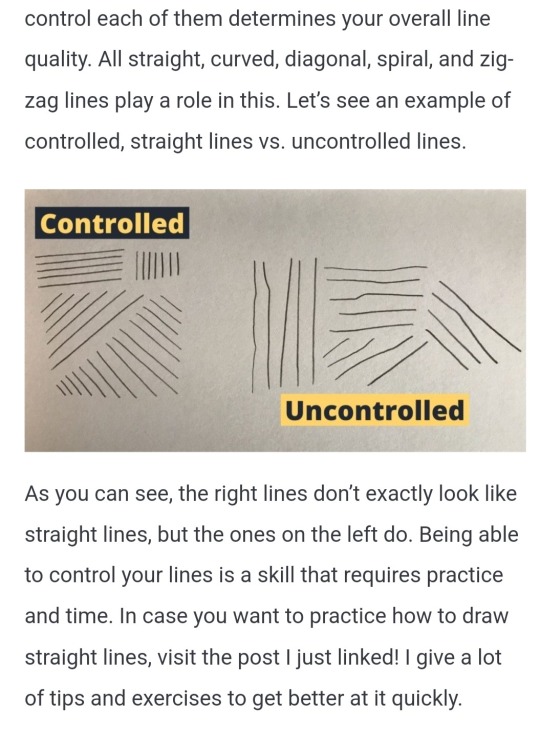
LOOK AT HOW CLEAN, FLUID AND CONFIDENT THESE LINES ARE DESPITE THAT HE IS DRAWING IN PEN!???
My assumption is that Blitzø is not using a reference for these drawings. You could make the argument that he has photos for M&M, Loona, and Stolas; however, he definitely does not have a photo of Striker.
I want to mention how dynamic of a pose he is drawing people in. He isn't avoiding hands at all. All of the hands are relatively accurate (Strikers especially).
In these drawings you see variation in line weight meaning parts of his lines are thicker to thinner. So Blitzø is purposely pressing harder and lighter to show variation and depth. His lines are very clean. I don't see repetitive Stokes and lines for the shapes. He is really confident with his mark making and you can tell because his lines aren't shaky at all.
By looking at his line quality and how clean it is you can tell he drew it quickly.
Not to mention he actually has a huge range of items he can draw confidently including and not limited to horses, weapons, leashes, cars, demons, and of course genitalia.
Blitzø isn't what you call a one trick pony 🐴 when it comes to what he can draw.
You can see this skill demonstrated in his other doodles.


You can even see this ability demonstrated in his drawings on the whiteboard

Okay anybody who has drawn on a whiteboard knows that they are difficult to draw on.
Whiteboards smear and are very streaky. In this photo you can tell where Blitzø made a mistake or changed information. Notice that none of his drawings have any smears. That means he did these drawings in literally one take.
I also want to mention his drawings in spring breakers. He is speed drawing directions and illustrating a plan perfectly to his employees.
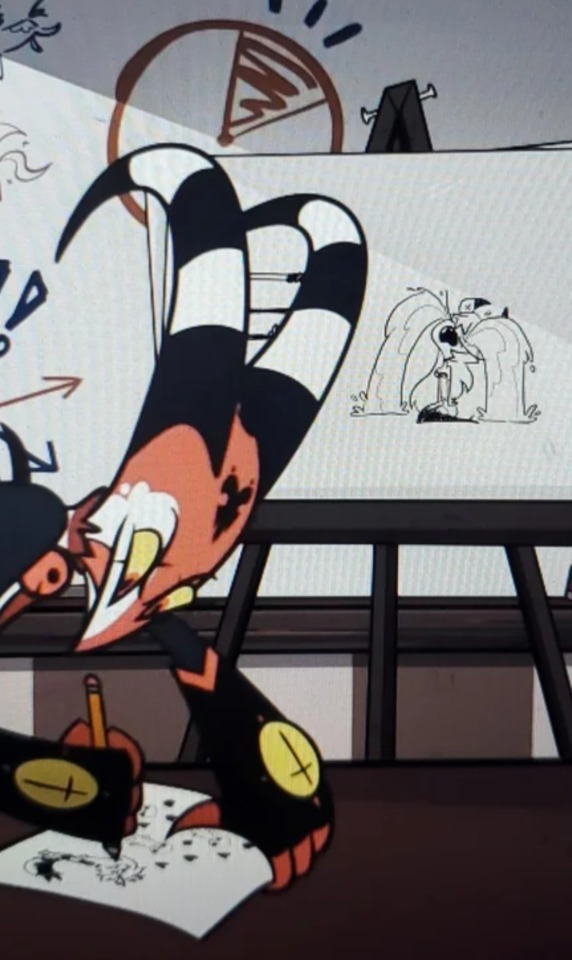
HE IS LITERALLY RAPID FIRE SPEED DRAWING HERE
His drawing of Veroskika which he DREW FROM MEMORY.
Demonstrates the following:
Line control, Line Confidence, Line Fluidity, Variation in Line weight, and still has relatively correct proportions!?
Basically shut up MOXIE?!!! He did a good job!
Why have we not seen more detailed Blitzø artwork?
Okay so I as we know in the show Blitzø puts his doodles everywhere. So if he is good at Art why isn't he showing his artwork he spent a long time on????
The answer: he's insecure
Showing someone your art is a very vulnerable action. This is especially true if you spent a long time on it.
If someone doesn't like or makes fun of your doodle you can brush it off and be like well it's only a sketch and I did it in under 5 min.
It's a lot easier to show someone a silly little horse drawing you did than something you poured your heart and soul into.
We already are aware that Blitzø is insecure and has self-esteem issues. He literally covers his face in the photos of himself throughout his apartment. He is a very guarded individual. Of course he wouldn't show people the art he spent hours on. What if people reject them? They judge him for spending that much time? What if they see how much he actually loves them?
Blitzø feels like the kind of person who would crumple up or destroy his art that he spends long amounts of time on. It's a way of self-sabotaging yourself and further self-loathing.
Now do I think he has these hours long art pieces/drawings????
ABSOLUTELY
My guess is that Blitzø most likely has a hidden sketchbook. Artists tend to draw their loved ones and especially their children and partners.
There is no doubt in my mind that Blitzø hasn't been doing long observational drawings of Stola's especially when he is sleeping.
He has most likely been drawing Loona all the time. Why do you think he takes all the photos? Those are his references. He has probably been drawing detailed artwork of his loved ones this whole time (and of course horses too lol).
In conclusion
Blitzø actually can draw really well because his doodles demonstrate high levels of skill in line quality.
Going forward I would really appreciate if someone actually finds Blitzø's sketchbook or portfolio of his artwork he spent large amounts of time on. It would be really cute. It would be adorable if Loona or Stolas found them.
Blitzø could gain more confidence and put is artwork he really cares about on display 🥺
I also just want Moxie to find out and eat his words. (Guys I swear I don't hate Moxie 😂)
Thank you for joining me here today on my Ted talk on how I think Blitzø is actually a talented artist. I'm just an art teacher who has problems with how much helluva boss lives in rent free in my head.
#helluva boss#blitzø#helluva blitzo#stolas#helluva theory#stolitz#blitzo is an artist you cannot tell me im wrong#blitzo doodles#helluva boss lives rent free in my head#art teacher analysis#Could you argue that they are good drawings because the artists who made the show know how to draw? yes. but this is a way more fun idea#YOUR GOING TO LOOK AT ME AND TELL ME IM WRONG??!!#Neurospizzzziee Helluva Analysis
184 notes
·
View notes
Text
The Inconspicuous Writing Gem: Daeran’s Look-alike Contest Breakdown

The Dance of Masks brought the long-anticipated last hurrah to the Knight Commander’s story. Although it was announced that the DLC would focus on the companions, I wasn’t holding my breath for substantial content that would actually enrich the characters’ plots. The game is already massive and has a ton of variables, so expecting the writers to continue storylines that can have multiple outcomes would be unreasonable. But one scene far exceeded my expectations and set the bar high for the rest of the expansion, rendering me more critical about some of its elements than I would normally be. The event in question may not appear as much, but the true artistry in writing stories driven by the player’s choice fully reveals itself in what we don’t see on the surface. Daeran’s look-alike contest varies greatly, depending on how his personal quest was resolved, and, therefore, serves as a semi-epilogue to his arc. I wanted to post an analysis of his character’s progression for quite some time, and this send-off is a fitting opportunity to delve into this matter. I’ll break down the differences in the new scene as well as in a few others and share my overall thoughts on what this addition brings to the table. Brace yourself because it’s going to be long.
I'll start with a quick reminder of what Daeran’s questline outcomes are, because I'm going to reference them a lot:
Good, in which he’s openly grateful to the Knight Commander despite having to face the tribunal, and Liotr, noticing their bond, intervenes so the Inquisition doesn't lock him up;
Lobotomy, in which Daeran reluctantly accepts his predicament of having to face the trial, Liotr doesn't support him and after the crusade, the Count is sent to the asylum and lobotomized;
HappyEvil, in which the Commander kills Liotr to secure Daeran’s freedom;
ArchEvil, in which Daeran doesn't have any trust in the Commander, feels deserted and murders Liotr to avoid the trial.
At first glance, there's nothing profound about Daeran’s festival quest — it fits his image to indulge in the vain act of self-celebration by choosing the most accurate imitation of himself. However, this simple setup proves itself clever when we realize that, by observing the contestants, he sees himself in a distorting mirror. Coincidentally, each participant appears to represent a different facet of the Count’s character. Therefore, his reactions to them speak volumes of the self-image and mindset he developed during the crusade in each scenario.
Among the doubles, we have an aasimar who mimics Daeran's arrogance and cruelty, and constantly interrupts other participants' speeches with mocking remarks.
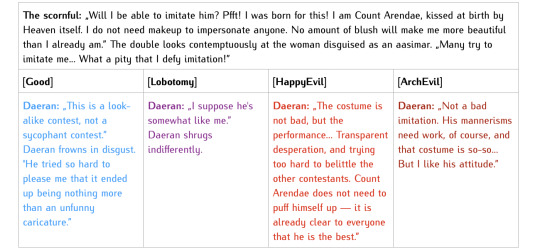
A woman who recreates Daeran's sophisticated bon vivant persona.

A drunkard who paints Daeran as a worthless and utterly unapologetic rake.

And finally, an innocent boy who keeps staring at Daeran with admiration and portrays him as a virtuous hero of the crusade.

After the presentation of the contestants is over, Daeran asks the Commander’s opinion. Again, his responses to their verdict vary in each case (unless they choose the cat), but the difference in how he reacts to being compared to the little boy is the most telling.
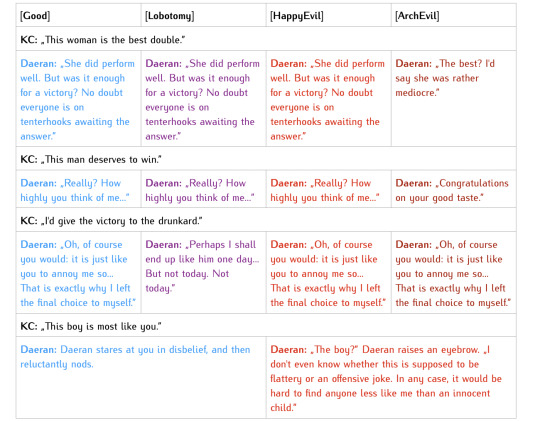
No matter what the protagonist suggests, the winner of the contest is fixed for each of the outcomes. If the Commander failed to earn Daeran's trust and he murdered Liotr himself, the conceited aasimar is declared the winner.

If the Commander killed Liotr, the Count awards the lady.

If the quest was resolved peacefully (either Good or Lobotomy), Daeran chooses the boy and has a heartwarming exchange with him.

This variety of possible scenarios and the way they are handled encapsulate why I consider Daeran's story so intricately woven and enjoyable to analyze. He's an incredibly flexible and dynamic character whose potential endings range from becoming a saint to a homicidal maniac. But what makes this duality and everything that comes in between so engaging is that all these vastly contradictory conclusions are equally organic and convincing, given his rich characterization and the player’s choices. The subtle yet significant divergences in the narrative paths maintain the integrity of his personality and prevent his evolution from seeming far-fetched while efficiently showcasing his growth or regression.
Regretfully, this attention to detail is missing from the other new scenes, which don't convey a similar sense of progression and can come off as somewhat disconnected from the rest of the playthrough. The rendezvous, for example, avoids references to how the player concluded Daeran's romance and quest. Given these plotlines' non-linearity, it's an understandable approach, but it prevents the scene from exploring deeper themes and hitting more emotional notes. What's particularly detrimental to the its overall intensity is the absence of exclusive dialogue for the True Love outcome. Ironically, it's the two worst endings that get unique and surprisingly heartfelt lines.
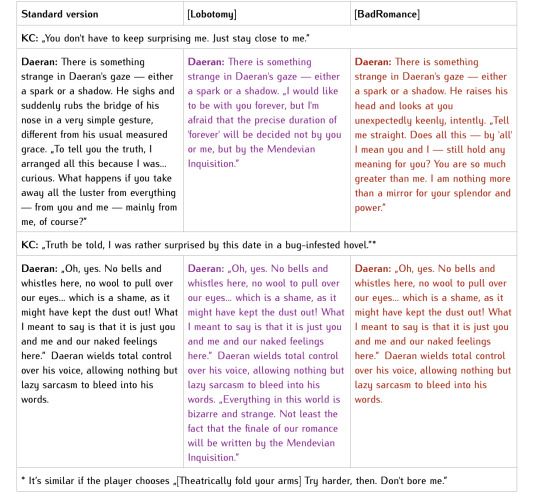
The difference is insignificant, however, because the conversation always plays out the same. All in all, the segment is nice and leaves a lot to the imagination, but only partially exploits its potential. Meanwhile, the festival mini-quest embraces the aforementioned strengths of the storyline's writing, giving every iteration of Daeran distinct dialogues that clearly demonstrate the impact the crusade and acquaintance with the Commander had on him.
I won't examine every dialogue branch in detail but will mainly focus on the Good scenario. As someone who likes this ending the best and even advocates the controversial writing in the final confrontation with Liotr, I always thought the narrative failed to properly sell its implied benefits. Apart from the closing conversation in the quest itself, late-game provides little reactivity to differentiate the outcomes, making it hard for the players to fully grasp the internal shift that Daeran undergoes. Comparison of said dialogue in various scenarios reveals his perspective in Good route as the least egocentric and overall most mature. Unfortunately, in an individual playthrough, these qualities can get overshadowed by the Count's dissatisfaction with the inconveniences he will eventually have to endure.

Aside from that, the effects of each resolution manifest only in Daeran's responses to one question in the romantic route and how he expressed his feelings regarding Galfrey’s death.
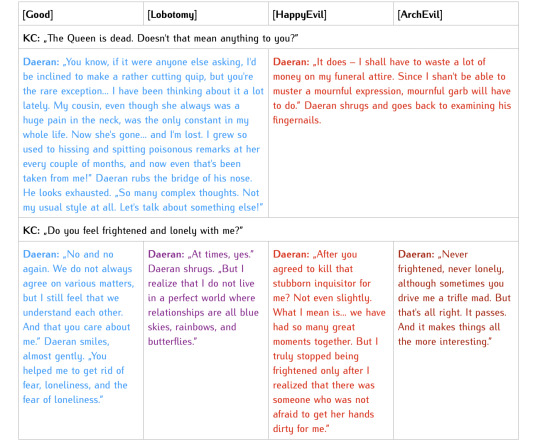
Even though they show evident contrast and serve as a much-needed emotional pay-off for the moral dilemma the player faced in the storyline finale, both are relatively minor, with the Queen one completely missable in most playthroughs. When combined with the similar omission of negative repercussions for Daeran’s moral condition and emotional maturity in other outcomes, it's not surprising many players believe he doesn’t ever change or that becoming better fundamentally clashes with his nature.
The discussed competition scene remedies the narrative’s deficiencies, ultimately proving this statement untrue. In the Good outcome, Daeran presents a reasonable dose of self-distance. When confronted with the drunk’s insults, he replies with humor and courtesy, which is a stark contrast to his reactions in the Evil outcomes and his past responses to criticism. Despite being hurt by the harsh judgment, he understands such a low opinion of himself is somewhat justified. The Count's mild response and his sensitivity to the suggestion that he's nothing more than an unfeeling scoundrel may even indicate that he has developed some remorse for his past actions. He also dismisses unwarranted flattery and distances himself from the brash egotism. All without falling into a spiral of gloom and self-deprecation that occurs in the Lobotomy scenario. Introspectiveness and vulnerability showcased here are a seamless continuation of the self-evaluation Daeran does in the High Trust version of his quest upon being supposedly betrayed by the Commander.
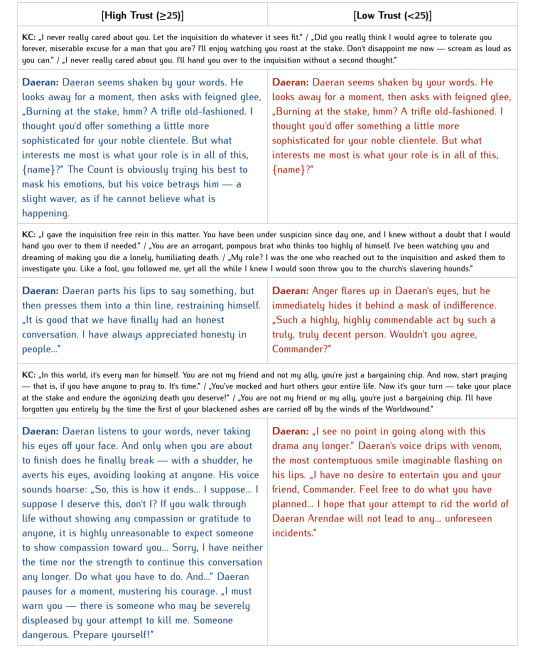
It's all the more unfortunate that the other interactions in the DLC don’t acknowledge these differences and instead return to the common denominator of all endings. As a result, the player will go from Daeran, who self-reflects and claims the aasimar presents an unfunny caricature of him, to Daeran in the tavern, who puffs himself up exactly like the guy (using even the same words) and seeks more sycophantic praise. While it's expected for him to put on an airy act and tease others, the absolute lack of self-awareness he previously exhibits in the Good route is quite jarring. Considering the complexity of the storyline as well as all sorts of limitations, such inconsistencies are inevitable (the base game already has a fair share of them) and in the end, one can easily reconcile them through their own interpretations. However, after being spoiled by a reactivity treat like the festival mini-quest, it's disappointing that the remaining dialogues lack similar nuance.
In the Good scenario, Daeran's behavior reinforces what we learn in the epilogue — that in this version, he has the most difficulty navigating through his newfound freedom and redefining himself in it. Choosing the winner of a silly contest shouldn't be hard for him, and it isn't in the Evil outcomes. There, the self-satisfied Count (who in both cases already has the blood of at least one innocent man on his hands) picks what he perceives as an idealized version of himself — be it the aestheticized depiction of his self-centredness or the unbridled and unyielding haughtiness. Noteworthily, in the Happy variant, Daeran openly flirts with the lady and, in both Evil paths, if not romanced, attempts to seduce his favored contestant. It’s peak narcissism, given the implications of the scene. In the peaceful outcomes, especially the Good one, the ordeal is a series of unpleasant self-reflections that even causes him to become overwhelmed by sorrow at one point. In the end, Daeran’s choice stems not from an ulterior motive or a desire to boost his ego but from genuine fondness for the boy. The youngster's belief in the Count’s kindness and heroism reminds him of his own innocence that was prematurely and brutally snatched from him. At his core, Daeran is not a self-sufficient master of his own fate but a helpless child thrown by unfortunate circumstances into otherworldly oppression and a vicious cycle of selfishness. In the Evil routes, he successfully deludes himself into believing he’s the former, but here, he realizes he’s the latter.
We're used to seeing Daeran scoffing at saccharine narratives and lofty ideals, and in the Evil versions, he's indeed annoyed with the boy’s portrayal of him. In one of them, he even anticipates him to be disenchanted, finding the prospect amusing. In the campaign's early stages, the Count voices his dissatisfaction with being enrolled in the crusade and laments the tarnishing of his ill reputation. Any suggestions that he may be secretly vulnerable are met with biting retorts. But now, Daeran doesn't disabuse the child and isn’t even bothered by being seen as a heroic figure. There also isn’t any objection when the Commander points out the similarity between him and the boy. He’s shocked they can see through him but decides to be honest and agrees with their assessment. Daeran’s sensitivity and his tendency to be more emotionally transparent with the protagonist is, at this point, a recurring theme in the peaceful outcomes, so it’s a shame that when they later choose to compliment his vulnerable soul, he's always equally dismissive.
Daeran is perfectly aware of how damaging cruel disillusionment can be to one’s psyche. As a child, he witnessed firsthand the powerlessness of good in the face of evil, the suffering adhering to moral principles can bring, and how those who claim to be righteous can turn out to be as callous and uncaring as hardened villains. These experiences left the young Count with a pessimistic view of the world and human nature, making him adopt coping mechanisms that only deepened his melancholy and loneliness. Knowing this, he wishes to spare the boy a similar fate and plays along to preserve his innocence.
In the non-peaceful outcomes, Daeran gives the signet away as if it was an insignificant bauble. But even though we barely ever see this side of him, some dialogues indicate he’s proud of his heritage and his ancestors' role in Mendev’s history. They were valiant defenders of the kingdom, who, for generations, protected its borders from any threat. This is who the Count, as a scion of the Arendae house, was originally destined to be and who, it so happens, the boy sees in him. Perhaps his take on him makes Daeran reflect on how differently things could have turned out had it not been for his family's demise and the Other’s interference. It undoubtedly revokes memories of his roots and deceased kin, since he not only rewards the child with the ring but also educates him on its meaning and sentimental value, expressing unexpected sincerity and kindness. In the Lobotomy scenario, this gesture is particularly bittersweet — with his impeding childless death, Daeran’s lineage is going to expire, making the memento the only way to keep its memory alive.
Finally, the Good version of the scene carries a deep symbolic significance. Daeran rewards one person who doesn't focus on his superficial traits or recreates the mask he hides behind. The image the boy paints of him may not be accurate, but while the other portrayals embody what the Count turned into under the Other's influence, this one shows what he could have been if he hadn’t lost the childish naivety he now longs for. And who he, despite his own skepticism, still can or perhaps even already started to become, thanks to the good protagonist's compassion and support. Just like the Commander, the boy views him as someone better than what his predicament forced him to be. And Daeran, confronted with sincere faith in him, cannot help but answer the call.
#pathfinder: wrath of the righteous#pathfinder wotr#pwotr#wotr#wrath of the righteous#owlcat games#daeran arendae#daeran#Дейран#my analysis
291 notes
·
View notes
Text
Dragon Age: The Veilguard settings details - Display and Graphics
This post is under a cut due to length.
This information comes directly from the game.
DA:TV menu 'pages': Display, Graphics, Audio, Controls, Gameplay, Interface, Accessibility, Other.
For some of the settings, additional detail on a specific one (the one that was selected at that particular point during the video, e.g. "Window Mode" was set to "Full Screen") is given after the general explanation/definition of the setting itself. These are in italics at the end of an entry.
DISPLAY
Display Mode
Active Monitor: Select the monitor for game display. Window Mode: Switches between full screen, windowed, and borderless windowed modes. You can press ALT+ENTER at any time to switch between full screen and windowed modes. In full screen mode, the game will play on the entire screen. Screen Resolution: Changes the game's display resolution. The game's level of on-screen detail is determined by the number of pixels it contains. Higher resolution increases the number of pixels displayed, which will result in a clearer image. This comes with a potential cost to performance. Refresh Rate: Sets how often your display will refresh game visuals. A higher refresh rate means a smoother picture, depending on your computer's hardware. Frame Rate Limit: Sets the maximum framerate for the game. VSync: Synchronizes the game's framerate with the display's refresh rate to prevent screen tearing.
Calibration
Brightness: Adjusts the intensity of the game's visuals. Makes all visuals lighter or darker. Contrast: Adjusting the contrast will change the difference in color and light between the brightest and darkest parts of the screen. Enable HDR: HDR (High Dynamic Range) mode provides enhanced color and contrast ranges. This option can only be enabled on supported displays. HDR must also be enabled in your operating system. Use the HDR Calibration option below to adjust. HDR Calibration: Launches the HDR calibration tool which adjusts the HDR settings to best match your display. The maximum brightness level should generally be adjusted to match what your HDR display will support. Measured in nits. This is only available when Enable HDR is turned on.
Upscaling
Unsample Method: Improve performance and visuals by rendering the game at a smaller resolution, then "upsampling" to a larger resolution for display. The pixels that make up the difference between the two resolutions are generated using advanced algorithms. Unsample Quality: Select the desired quality level for the upsampling method selected. DLSS Frame Generation: DLSS Frame Generation can generate additional frames that boost your overall frame rate. In order to use Frame Generation, you must have an NVIDIA RTX 40-series graphics card. NVIDIA Reflex: NVIDIA Reflex is a technology that helps reduce input latency while playing the game. In order to take advantage of NVIDIA Reflex's feature, you must have a supported NVIDIA graphics card. Anti-Aliasing: Anti-Aliasing smooths out pixels along the edge of objects that can look sharp or jagged in certain situations. Temporal Anti-Aliasing (TAA) uses information from current and past frames to address aliasing issues. The high setting uses a large range of frames and will result in a higher quality anti-aliasing effect, but with a higher performance cost.
Resolution Scaling
Render Scale: Controls the resolution the game is rendered at relative to your display resolution. Settings below 100% may decrease visual fidelity, but can improve performance. Settings above 100% may increase visual fidelity, but can negatively impact performance. Dynamic Resolution Scaling: Automatically lowers the game's resolution in real-time to maintain the target frame rate. Target Frames Per Second: Determines the target frame rate for dynamic resolution scaling. Minimum Resolution Scale: Determines how low the resolution can be scaled when Dynamic Resolution Scaling is active.
GRAPHICS
Graphics Preset
Graphics Preset: Graphics presets are predefined configurations that simultaneously adjust multiple graphics settings to achieve a balance between visuals and performance. Restart required for setting change. Maximizes visual fidelity by setting most graphics options to their highest values. Recommended for the Ultra hardware specification tier.
Textures
Texture Quality: Selects the level of detail and resolution for textures applied to objects in the game. Higher settings will result in more detailed textures, potentially at the cost of performance. Restart required for setting change. CPU - Moderate. GPU - Moderate. VRAM - Major. Texture Filtering: Adjusts the appearance of textures at varied angles and distances. Higher settings will increase texture quality, though potentially at the cost of performance. CPU - Minor. GPU - Moderate. VRAM - Minor.
Light and Shadow
Lighting Quality: Adjusts the appearance of shadows, reflections, and light-scattering. Higher settings increase the visual fidelity of light effects. CPU - Minor. GPU - Moderate. VRAM - Major. Contact Shadow: Contact Shadows improves the appearance of shadows when objects are close to one another. It fills gaps between objects and shadows that can occur with static lighting. CPU - Minor. GPU - Moderate. VRAM - Minor. Ambient Occlusion: Ambient Occlusion is a technique to simulate soft shadows where objects are close together or where surfaces meet. This makes the scene look more realistic. Disabled when Ray-traced Ambient Occlusion is enabled. CPU - Minor. GPU - Major. VRAM - Minor. Disables Ambient Occlusion. This potentially increases performance at the cost of visual fidelity. Screen Space Reflections: Screen Space Reflections simulate reflections of objects and light on visible surfaces. Enabling this will result in high-quality reflections. Disabled when Ray-traced Reflections are enabled. CPU - Minor. GPU - Moderate. VRAM - Moderate. Volumetric Lighting: Adjusts the appearance of volumetric lighting effects. This simulates how light interacts with atmospheric elements like fog, smoke, dust, and clouds. Higher settings increase the quality of these types of elements. CPU - Minor. GPU - Moderate. VRAM - Minor. Sky Quality: Adjusts the appearance of the sky, clouds, and celestial bodies like the sun and moon. CPU - Minor. GPU - Moderate. VRAM - Minor.
Ray Tracing
Ray-traced Reflections: Enables the use of Ray-Tracing to simulate realistic reflections of objects and light on reflective surfaces. This is a more advanced technique and requires specialized Ray Tracing compatible hardware. CPU - Major. GPU - Major. VRAM - Moderate. In selective mode, the game will only enable Ray-traced Reflections in specific areas that can best take advantage of the feature. Ray-traced Ambient Occlusion: Enables the use of Ray Tracing to simulate soft shadows where objects are close together or where surfaces meet. This makes the scene look more realistic. This is a more advanced technique and requires specialized Ray Tracing compatible hardware. CPU - Major. GPU - Major. VRAM - Moderate. Ray-Traced Ambient Occlusion is always on. Ultra Ray Tracing: Enables the highest level of ray tracing effects, which provide better quality visuals at the cost of performance. This setting is available on the Ultra and Custom graphics presets and is only recommended for high-end graphics cards.
Geometry
Level Of Detail: Adjusts the distance at which objects are visible and the level of detail as they get father away from the camera. Higher settings increase the visual quality of objects at distance. Restart required for setting change. CPU - Major. GPU - Major. VRAM - Moderate. Strand Hair: Strand hair simulates the appearance and movement of individual strands of hair. Enabling this will result in more realistic and natural-looking hair. CPU - Major. GPU - Major. VRAM - Moderate. Terrain Quality: Terrain is the natural landscape and ground surfaces. Higher settings will increase the detail and overall quality. CPU - Moderate. GPU - Major. VRAM - Moderate. Terrain Decoration Quality: Adjusts the appearance and detail of terrain elements like rocks, vegetation, and other environmental objects. Higher settings will increase the quality and density of the terrain elements. CPU - Moderate. GPU - Major. VRAM - Moderate. Visual Effects Quality: Adjusts the quality and detail of visual effects throughout the game. This includes particle effects, decals, and screen effects. Higher settings will result in higher quality effects. CPU - Minor. GPU - Moderate. VRAM - Moderate.
Camera Effects
Depth of Field: The Depth of Field effect causes some elements of the scene to be in focus, and others to be out of focus. This effect is generally only used in cutscenes and conversations. CPU - Minor. GPU - Minor. VRAM - Minor. Depth of Field is only enabled in cinematic sequences. Vignette: The vignette creates a subtle darkening of the image towards the edges of the screen during cinematics and gameplay. This is generally used to enhance the atmosphere of scenes. CPU - Minor. GPU - Minor. VRAM - Minor. Motion Blur: Motion Blur slightly blurs fast-moving objects. This helps make motion appear smoother and more natural. CPU - Minor. GPU - Minor. VRAM - Minor. Post Processing Quality: Adjusts the overall quality of the post process effects above like depth of field, bloom and motion blur. Higher settings will result in higher quality effects. CPU - Minor. GPU - Moderate. VRAM - Minor. Field of View: Adjusts the field of view, which changes how much of the game world is visible during gameplay. A higher field of view allows you to see more of the game world. CPU - Major. GPU - Major. VRAM - Moderate.
[source]
#dragon age: the veilguard#dragon age the veilguard spoilers#dragon age: dreadwolf#dragon age 4#the dread wolf rises#da4#dragon age#bioware#video games#long post#longpost#if you're thinking#fel. why did u type this out#sometimes i search my own blog for info or the answers to things and it will only show up if its written as text :D
68 notes
·
View notes
Text
COMMISSIONS OPEN!
Hello everyone! Since the University is winding down for the rest of the year, I am reposting my commission sheet. Commissions will go towards saving for living and university!
All payments will go through my Ko-fi!
I will draw; Furry, Gore (depending on intensity), Real People, OC x Canon, OC, Fandom work, and Shipping Art!
I will NOT draw; NSFW or Fetish art, Proship or Offensive content and complex robots, complex armour and weapons, or mecha (Sorry!)
Please don't hesitate to ask if you're unsure what I will and won't draw.
Please see the cut below if you're Interested!
Prices
All prices are listed in Australian Dollars, and the price range varies on complexity and add-ons!
Headshots start ranging at $10-$35.

Busts start ranging at $12-$40.

Half body starts ranging at $14-$60.

3/4 starts ranging at $18-$70.

Full body starts ranging at $18-$80

Character Reference sheets start at $50.

Add-Ons and Colouring
Colouring
There are 4 levels of complexity: Lineart (usually monochromatic), flat colour, full render (high lights and shading) and dynamic (dynamic angles, lights, poses.) I have attached samples of dynamic colouring and artwork below.
The dynamic option is not available for headshots and busts.
Backgrounds & Additional Characters
Simple backgrounds such as gradients, shapes or simple patterns are free. Otherwise, it will be a transparent PNG or have a coloured background.
Line art, flat coloured, full render and dynamic backgrounds will cost extra. Depending on the colouring and complexity, backgrounds will range from $5-$40.
Additional Characters will cost extra. They have line art, flat coloured, full render and dynamic options ranging from $5-$30.
Add-ons are not available for headshots and busts.
Face claims, mood boards or references are recommended to be provided for the most accurate commission.
The commission will not be accepted or begun without receiving full payment.
I reserve the right to turn down any commission or cancel any commission and refund half or full of the price, depending on how far I've gotten.
ANY AND ALL COMMISSION ARTWORK CANNOT BE USED FOR A.I.
Thank you for your time :]





#sealzspeakz#sealzstuff#sealzart#commissions open#furry#fallout#OC#art#digital art#commissions#commission sheet#art commissions#commission#art comms open#furry art#protogen#protogen art#comms open
11 notes
·
View notes
Text
AL.CO file Quintessence




Subject:Quintessence
Species: Empowered-Human
Pronouns:They/Them
Type:Other(an inherited genetic trait carried by their maternal family)
Level:Alpha
Description
Alexander is one in a long line of empowered humans with abilities inherited genetically through the generations. The exact origin of this familial trait are unknown. [it is noted that almost all of Alexander’s material family posses a form or limited degree of Alex’s abilities]
Physically like many empowered humans Alexander possesses a resilience to damage more like that of a pokemon
Alexander is able to conduct[absorb\Drain] the dynamic living energy’s generated by pokemon, render said energy down into more basic forms , store and utilize that energy for a variety of effects depending on the quantity, type and move which has been conducted.
In broad strokes, they are able to conduct energy from moves performed on them or through physical contact with a Pokémon[also some human], renders that energy into its most basic form, generally(exceptions exist) that of a singular type when conducted from a move , or more when when conducted directly from a Pokémon(s). Once that energy is rendered inside their body, they are able to manipulate it in a variety of ways depending on the energy-types they have available to them. In general, they are either able to imbued this energy onto others for their use, or utilize the energy themself at their discretion.
(For example, the energy rendered by absorbing a solarbeam, will be grass type , but energy draw directly from Breeloom will be both Grass and Fighting)
On a basic level, all energy-types when used have a few overarching abilities, which are shared, regardless of type. When in use the individual utilizing said energy[referred to as Charged], will experienced varying degrees of heightened strength, speed, agility, reflexes, alertness, stamina, and if in possession, a greater ability to utilize abilities, they possess.
On a more specific level, each energy-type has a range of additional characteristics that are imbues on to its user. Said characteristics can overlap, when more than one energy type is being used. When Alexander or another individual are sufficiently Charged the individuals, utilizing said energy may learn how to generate Move phenomenon. Alexander, as the possessor of this ability has learned to manifest a host of move phenomenon of various types when appropriately Charged.
In addition to their ability to generate move phenomenon and perhaps the defining aspect of their abilities that qualify Alexander as an alpha level empowered human is their ability to generate non-move, quantifiable phenomenon. In particular with the energy-types, Alexander has the most experience with. Even able to generate emergent abilities by combining energy-types to generate unique effects.
Energy-Type Characteristics
[it is of note that Alexander has not spent sufficient time conducting energy with every type to determine the individually unique characteristics of each ,As such only the ones, Alexander has sufficient evidence of, will be listed below.]
Electric-type energy-enhance speed , electroreception ,access to electric type Moves and general Electrokinesis.
Flying-type energy-enhanced accuracy and positional awareness access to flying type moves and general aerokinesis.
Grass-type energy-greater stamina, photometabolize light ,access to grass type moves and general florakenesis
Bug-type energy- stronger reflexes, access to bug type moves, energy carapace generation
Water-type energy-pressure resilience ,enhanced lung capacity ,access to water type moves, general Hydrokinesis
Fire-type energy-high temperature resilience access to fire type moves general Pyrokinesis
Ice-type energy-low temperature resilience access to ice type moves , general cryokinesis
Psychic-type energy- ESP , access to psychic type moves, general psychokinesis
Ground-type energy-seismic sense , access to ground type moves , limited geokinesis(sand,soil,clay and mud)
[Awaiting updates]
#Al.co files#pokemon#pkmn#pokemon art#pkmnart#pokeart#pkmn fanart#pokegraphic#rotumblr#rotomblr#irl pkmn#pokebloging#masquerain
17 notes
·
View notes
Text
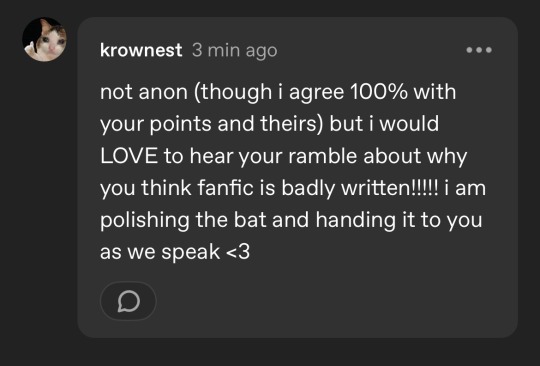
@krownest thank you for handing me the bat my liege let us get down and dirty
okay so disclaimer before we start this is my opinion and i’m not calling people bad or saying they should stop writing yada yada yada etc etc (also wow this got long oops. readmore on ye)
i think the reason there’s such a deluge of “bad” fanfic comes down to a couple different reasons, some of them interconnected and some of them symptoms of larger issues.
i wrote and rewrote my definition of what “bad fanfic” is like, seven times, but in the end i think the characteristics of it are essentially: fanfic which makes you stop reading or become disappointed due to any number of issues, especially those which, if they were changed, would render the fanfic itself fundamentally a different piece of art (so, MOSTLY not cosmetic).
some of the most common issues i, personally, have, when trying to find new fanfic to read are ones that i’m sure you’re fairly familiar with: characterisation issues, dynamics which feel “off”, direct contradiction to the canonical themes without any seeming understanding that it is, in fact, contradictory, and prose. that last one is the trickiest, so we’ll set it aside for the moment being.
i think the first three tie together fairly neatly, and have simple to answer causes: one, people are writing not based off canon, but off fanon; two, people are not, generally, trained in media and literature comprehension and analysis as anything but a basic set of tools to pass their primary/secondary school exams; and three, tied in with one and two, people aren’t writing concepts as they would happen if they were applied to x character(s), they’re writing what THEY would want to happen in x scenario, and slapping the characters’ names over them.
obviously, we could sit here and argue for days about what “characterisation” is, what “canon dynamics” are, hell, what “canon” is, but for our intents and purposes: let us define these as the range of plausible interpretations one can draw from a canon, and find sources or references to argue the validity of (and make no mistake, this doesn’t mean there’s “one true [characterisation/dynamic/canon]”—there is, let us say, a dialectical continuum of possibilities, and the extremes, in any direction, are entirely unsupported, or outright denied by, canon). (i could tack on a rant here about why i think disagreement and different interpretations in fandom is not only healthy, but NECESSARY, as long as no singular faction dominates and forces the others to feel as if they will be ostracised if they suggest otherwise, but i digress.)
these aren’t problems that can be fixed overnight. media analysis is a tool that takes time and effort to grow, and when it comes to the average fan, in 2024, participating in an averagely-sized fandom: there is no external force driving them to stretch that muscle. fandom has, for better or worse, moved past what it once was: no longer gated communities with high bars of entry, which necessitate skill and effort and passion to enter, but more open and free for all. make no mistake, this isn’t necessarily bad—there are many, MANY problems with old fandom, not the least being cults of personality, actual cults, harassing commenters, etc, etc. my point is simply that new age fandom, by design, doesn’t require you to put in as much work—the barriers to reading fic, to POSTING fic, are far lower than they, perhaps, have ever been. open ao3, send an invite request, and bam: a week or so and change later, you, too, can post your very own writing for thousands of people to see, should they simply look.
this ties, i think, into prose; all of these things are, by nature, hard to do. some people have a bit more instinctive knack for them—but even if they do, they’ll never be able to improve if they don’t push themselves, if they don’t practice, if they don’t try and engage with canon and think critically about said canon and try, really try, to put just as much into writing as an athlete would put into running, or javelin, or swimming—but unlike physical sports, writing is not something with immediate, tangible results. it takes TIME. and in the end, it’s much easier for people to write the same fifteen tropes, the same variations on ship themes, follow fanon. i’m not here to be a prescriptivist and tell you how you MUST write fanfic—i really don’t care that much, honestly. if you want to do that, fine, be my guest; but i’m allowed to complain about it on my blog.
to end this post on a lighter note, if you do feel your fanfic isn’t very good, and you want to improve: i have suggestions! you should read as much as you can (published works, especially experimental styles, are good for for this), get your hands on as much meta (for characters, dynamics, themes, what have you), or if you can’t find any, practise writing your own the way you’d write an essay, and most keyly: don’t do things in your writing just because they’re popular in the fandom.
okay, cut! that’s all, for now, i think
#thank you beloved mutual for the opportunity i hope this is explained thoroughly#if there’s anything you want to hear more on i can respond#c.txt
8 notes
·
View notes
Text
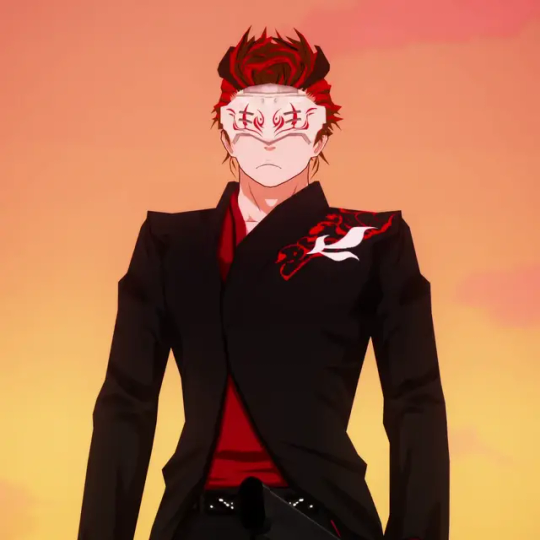
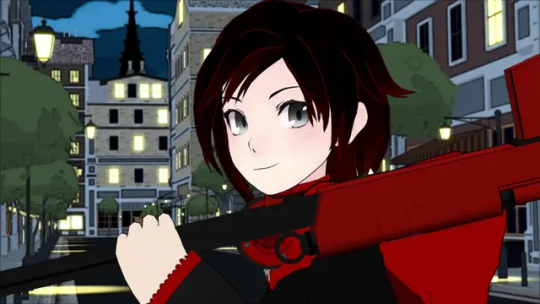
Adam Taurus vs. Ruby Rose: A Foil Comparison
Adam Taurus and Ruby Rose in RWBY serve as compelling foils, their shared reliance on signature weapons and rose motifs contrasting with their opposing ideologies, leadership styles, and moral paths. Adam’s spiteful extremism contrasts with Ruby’s pure-hearted heroism, highlighting themes of vengeance versus hope.
Similarities
Close Relationships with Blake: Both have significant ties to Blake Belladonna. Adam, Blake’s former partner in the White Fang, has an abusive, manipulative relationship with her, marked by his vow to destroy everything she loves (e.g., Volume 6 confrontation). Ruby, as Blake’s teammate and friend in Team RWBY, fosters a supportive bond, encouraging Blake’s growth (e.g., Volume 6 teamwork). Their connections to Blake drive their actions, shaping their narrative roles.
Fiery Combat Passion: Both exhibit intense passion in battle. Adam revels in combat, laughing during fights and unleashing devastating attacks with his Semblance, Moonslice (e.g., Volume 3 Yang’s arm severance). Ruby enjoys fighting Grimm, grinning during battles with Crescent Rose (e.g., Volume 1 Grimm slaying). Their enthusiasm fuels their combat prowess.
Weapon Dependency: Both rely heavily on their signature weapons. Adam’s sword, Wilt, channels his Semblance to absorb and release energy, rendering him vulnerable when disarmed (e.g., Volume 6 Blake and Yang fight). Ruby depends on Crescent Rose, a scythe-sniper rifle, struggling without it (e.g., Volume 4 unarmed training). Their weapons define their fighting styles.
Speed and Visual Echoes: Both move with exceptional speed, leaving visual trails. Adam’s Semblance creates shadow-like silhouettes during rapid attacks (e.g., Volume 3). Ruby’s Semblance transforms her into rose petals, leaving a petal trail at high speeds (e.g., Volume 4). Their speed enhances their combat effectiveness.
Rose Motifs: Both are associated with rose imagery. Adam’s jacket emblem and weapon names (Wilt and Blush) evoke wilting roses, symbolizing his corrupted ideals. Ruby’s brooch and Semblance’s petal bursts represent scattering roses, reflecting her vibrant hope. Their rose motifs tie them symbolically.
Differences
Role and Arc: Adam is a consistent antagonist, leading the White Fang with extremist goals until his death in Volume 6. Ruby is a steadfast protagonist, leading Team RWBY to protect Remnant from Salem (e.g., Volume 8). Adam’s villainy contrasts with Ruby’s heroism.
Combat Style: Adam is a close-range swordsman, using Wilt and Blush for precise, energy-absorbing strikes (e.g., Volume 3 Spider Droid bisecting). Ruby combines scythe melee with sniper rifle precision, using Crescent Rose for versatile attacks (e.g., Volume 1). Adam’s focused lethality opposes Ruby’s dynamic versatility.
Background: Adam, a Faunus, is shaped by trauma from the SDC branding on his face, fueling his spiteful extremism (e.g., Volume 6 flashback). Ruby grows up in a loving family with Taiyang and Yang, inspired by her mother Summer’s heroism (e.g., Volume 4). Adam’s pain contrasts with Ruby’s supportive upbringing.
Moral Evolution: Adam’s morality degrades from equality advocate to Faunus supremacist, driven by vengeance (e.g., Volume 5 Sienna murder). Ruby’s moral compass remains heroic, guided by a desire to protect others (e.g., Volume 8). Adam’s corruption opposes Ruby’s steadfast purity.
Motivations: Adam fights for personal retribution and Faunus domination, targeting Blake and humanity (e.g., Volume 5 Haven attack). Ruby fights for justice and unity, protecting Remnant from Grimm and Salem (e.g., Volume 6). Adam’s selfishness contrasts with Ruby’s altruism.
Visual Motifs: Adam’s bull motif, with horn-like mask markings, reflects his aggressive, domineering nature (e.g., Volume 3). Ruby’s wolf motif, seen in her pajamas and ammo pouch, symbolizes loyalty and pack unity (e.g., Volume 1). Adam’s brute strength opposes Ruby’s communal spirit.
Adam is a corrupted character copy of The Beast while Ruby is a virtous character copy of The Big Bad Wolf
Social Influence: Adam alienates his White Fang followers, abandoning them and losing loyalty (e.g., Volume 5 “Haven’s Fate”). Ruby inspires Team RWBY and allies, uniting them with optimism (e.g., Volume 6). Adam’s divisiveness contrasts with Ruby’s unifying leadership.
Emotional Triggers: Adam’s spite is triggered by betrayal, such as Blake’s defection, fueling his vendettas (e.g., Volume 6). Ruby’s passion is sparked by threats to her loved ones, driving protective actions (e.g., Volume 3). Adam’s destructive rage contrasts with Ruby’s constructive resolve.
Redemption Potential: Adam, consumed by spite, has no redemption arc, dying unrepentant (e.g., Volume 6). Ruby, as a hero, focuses on growth from naivety to maturity (e.g., Volume 8). Adam’s irredeemability opposes Ruby’s development.
Physical Expressions: Adam’s red hair and clothing glow with his Semblance, emphasizing his destructive power (e.g., Volume 3). Ruby’s silver eyes glow when unleashing their anti-Grimm power, signifying hope (e.g., Volume 6). Adam’s menacing glow contrasts with Ruby’s divine light.
Foil Dynamic
Adam and Ruby’s foil relationship underscores vengeance versus hope:
Villainy vs. Heroism: Adam’s spiteful extremism as a White Fang leader contrasts with Ruby’s pure-hearted leadership of Team RWBY, highlighting their opposing moral paths.
Trauma vs. Support: Adam’s branding trauma fuels his hatred, while Ruby’s loving family fosters her optimism, shaping their divergent motivations.
Destruction vs. Protection: Adam’s combat focuses on devastating single strikes for vengeance, while Ruby’s versatile attacks aim to protect, reflecting their contrasting purposes.
Isolation vs. Unity: Adam’s manipulative leadership isolates him, while Ruby’s inspirational presence unites her team, emphasizing their social impacts.
Corruption vs. Purity: Adam’s wilting rose motif and bull-like aggression symbolize his fall, while Ruby’s scattering roses and wolf-like loyalty reflect her enduring hope.
Their shared ties to Blake, weapon dependency, and rose motifs anchor their foil dynamic, with Adam’s destructive vengeance illuminating Ruby’s resilient heroism, reinforcing RWBY’s themes of choice and redemption.
Conclusion
Adam Taurus and Ruby Rose’s foil dynamic highlights how shared traits—Blake’s bond, combat passion, and rose imagery—lead to contrasting journeys. Adam’s vengeful villainy, traumatic past, and divisive leadership contrast with Ruby’s heroic purity, supportive upbringing, and unifying spirit, emphasizing the power of choice in shaping their legacies.
#rwby#rwby shitpost#rwbyfandom#rwbyfndam#rwbyfndm#rwby fndm#rwby fandom#RWBY villains#rwby foils#rwbypost#rwby post#rwbyshitpost#rwby comments#rwby comment#fandom rwby#rwby foil#rwby ruby#rwby ruby rose#rwbyrubyrose#ruby rose#ruby rwby#ruby rose rwby#ruby#rose#adam rwby#rwby adam#adam taraus
6 notes
·
View notes
Text
Web to Mobile: Building Seamless Apps with .NET"
.NET is a effective, flexible, and open-supply developer platform created with the aid of Microsoft. It enables the creation of a huge range of applications—from computing device to cellular, net, cloud, gaming, and IoT. Over the years, .NET has evolved substantially and has become one of the maximum extensively used frameworks inside the software improvement enterprise.
Dot Net Programming Language

A Brief History of .NET
The .NET Framework become first delivered through Microsoft in the early 2000s. The original cause turned into to offer a steady item-oriented programming surroundings regardless of whether code became stored and finished locally, remotely, or via the internet.
Over time, Microsoft developed .NET right into a cross-platform, open-supply framework. In 2016, Microsoft launched .NET Core, a modular, high-performance, cross-platform implementation of .NET. In 2020, the company unified all its .NET technologies beneath one umbrella with the discharge of .NET five, and later persisted with .NET 6, .NET 7, and past.
Today, the unified platform is actually called .NET, and it allows builders to build apps for Windows, macOS, Linux, iOS, Android, and greater using a single codebase.
Key Features of .NET
1. Cross-Platform Development
One of the maximum tremendous features of present day .NET (publish .NET Core) is its ability to run on a couple of platforms. Developers can construct and deploy apps on Windows, Linux, and macOS with out enhancing their codebases.
2. Multiple Language Support
.NET supports numerous programming languages, together with:
C# – the maximum extensively used language in .NET development
F# – a purposeful-first programming language
Visual Basic – an smooth-to-analyze language, regularly used in legacy programs
This multilingual capability allows developers to pick out the nice language for their precise use cases.
3. Extensive Library and Framework Support
.NET offers a comprehensive base magnificence library (BCL) and framework libraries that aid the whole lot from record studying/writing to XML manipulation, statistics get entry to, cryptography, and extra.
Four. ASP.NET for Web Development
ASP.NET is a part of the .NET platform specially designed for net improvement. ASP.NET Core, the cross-platform model, permits builders to build scalable internet APIs, dynamic web sites, and actual-time packages the usage of technology like SignalR.
5. Rich Development Environment
.NET integrates seamlessly with Visual Studio, one of the most function-wealthy integrated development environments (IDEs) available. Visual Studio offers capabilities together with IntelliSense, debugging tools, challenge templates, and code refactoring.
6. Performance and Scalability
.NET is thought for high performance and scalability, especially with its guide for asynchronous programming using async/wait for and its Just-In-Time (JIT) compilation.
7. Secure and Reliable
.NET presents sturdy safety features, including code get entry to security, role-based protection, and cryptography training. It also handles reminiscence management thru rubbish series, minimizing reminiscence leaks.
Common Applications Built with .NET
1. Web Applications
With ASP.NET Core, builders can create cutting-edge, scalable internet programs and RESTful APIs. Razor Pages and Blazor are technology within ASP.NET Core that help server-facet and purchaser-facet rendering.
2. Desktop Applications
Using Windows Forms or Windows Presentation Foundation (WPF), builders can build conventional computing device applications. .NET MAUI (Multi-platform App UI) now extends this functionality to move-platform computer and cellular programs.
3. Mobile Applications
Through Xamarin (now incorporated into .NET MAUI), developers can create native mobile applications for Android and iOS the usage of C#.
4. Cloud-Based Applications
.NET is nicely-acceptable for cloud development, in particular with Microsoft Azure. Developers can build cloud-local apps, serverless capabilities, and containerized microservices the usage of Docker and Kubernetes.
5. IoT Applications
.NET helps Internet of Things (IoT) development, allowing builders to construct applications that engage with sensors and gadgets.
6. Games
With the Unity sport engine, which helps C#, developers can use .NET languages to create 2D, three-D, AR, and VR games.
Components of .NET
1. .NET SDK
The Software Development Kit includes everything had to build and run .NET packages: compilers, libraries, and command-line tools.
2. CLR (Common Language Runtime)
It handles reminiscence control, exception managing, and rubbish collection.
Three. BCL (Base Class Library)
The BCL offers center functionalities including collections, record I/O, records kinds, and extra.
4. NuGet
NuGet is the package manager for .NET. It lets in builders to install, manage, and share libraries without problems.
Modern .NET Versions
.NET five (2020): Unified the .NET platform (Core + Framework)
.NET 7 (2022): Further overall performance enhancements and more desirable APIs
.NET 8 (2023): Continued attention on cloud-native, cellular, and web improvement
Advantages of Using .NET
Cross-platform assist – construct as soon as, run everywhere
Large developer network – widespread sources, libraries, and frameworks
Robust tooling – especially with Visual Studio and JetBrains Rider
Active improvement – backed by using Microsoft and open-source community
Challenges and Considerations
Learning curve – particularly for beginners due to its giant atmosphere
Legacy framework – older .NET Framework tasks aren't like minded with .NET Core or more recent variations without migration
Platform differences – sure APIs or libraries might also behave in a different way throughout operating systems
Getting Started with .NET
To begin growing with .NET:
Install the .NET SDK from the legitimate .NET internet site.
Create a new project: Use the dotnet new command or Visual Studio templates.
Write code: Develop your logic the usage of C#, F#, or VB.NET.
#btech students#bca students#online programming courses#offline institute programming courses#regular colleges university#Dot Net Programming Language
2 notes
·
View notes
Text
Why are the headlights on race cars tinted yellow?
The yellow color design of racing headlights is based on the comprehensive consideration of performance optimization, regulatory tradition and visual recognition. The following is a detailed analysis:
1. Improve optical performance in bad weather
Physical advantages of yellow light:
Wavelength range: Yellow light (about 580-590nm) has a longer wavelength than white light (400-700nm full spectrum), has a low scattering rate in rain, fog or dusty environments, and has a penetration increase of about 30% (according to the French National Meteorological Service).
Contrast enhancement: Yellow light is more easily recognized by human retinal cones in low visibility conditions (peak response of bright vision is 555nm), helping drivers to identify track edges and obstacles faster.
Practical application:
Le Mans 24 Hours: Morning fog is often encountered in night stages. Yellow light can penetrate the mist 300 meters away, while white light can only cover about 200 meters.
Rally (such as WRC): Headlights need to penetrate the dust and sand, and yellow light filters (such as Osram Yellow Boost) can extend the effective lighting distance to more than 500 meters.
2. Historical traditions and competition rules
French regulatory heritage:
In 1936, the French government required civilian vehicles to use amber lights to reduce glare for oncoming drivers. This regulation influenced early racing car designs (such as the Bugatti Type 57G Tank).
Although the regulation was abolished in 1993, events such as Le Mans still retain yellow light as a cultural symbol.
Mandatory requirements of competition rules:
FIA GT3: Some tracks (such as Spa-Francorchamps) require participating vehicles to use yellow auxiliary lights in rain battles (compliant models such as HELLA Rallye 4000 Yellow).
Dakar Rally: mandatory headlights must pass IP6K9K dustproof certification, and yellow light filters can reduce visual fatigue caused by dust reflection.
3. Brand identity and visual strategy
Iconic design language:
Porsche: From 917K to the current 911 RSR, yellow headlights (with green body) have become a classic element of Le Mans' "Gulf paint", enhancing brand recognition.
Toyota Gazoo Racing: TS050 Hybrid headlights use amber LEDs, which form a high contrast with the red body, making it easier for media cameras to track.
Psychological suggestion:
Yellow light conveys "aggression" and "speed", which is in line with the visual aesthetics of racing sports (refer to Pantone color psychology research).
4. Technology Evolution and Modern Alternatives
Filters vs. Native Yellow LEDs:
Traditional racing cars use coated glass filters (such as Plexiglas AMC yellow models), which cost about $50/piece and have a transmittance of 92%.
Modern solutions use custom spectrum LEDs (such as Cree XP-L2 580nm chips), which reduce energy consumption by 40% and have a lifespan of 10,000 hours.
Adaptive lighting technology:
Some LMDh prototypes (such as the Audi R18) are equipped with intelligent systems that can dynamically switch between yellow/white light modes:
Sunny day: White light (6500K) provides maximum illumination (120,000 lumens).
Rain and fog: Switch to yellow light (3000K) to reduce reflected glare.
5. Controversy and exceptions
Opposing viewpoints:
Some studies (such as the MIT 2022 report) point out that yellow light is inferior to white light in color rendering on dry nighttime tracks, which may obscure details (such as oil stains on the road).
Some events (such as NASCAR) prohibit yellow headlights to simplify technical standards due to closed tracks and no complex weather.
Alternative solution examples:
Formula E: All-electric racing cars use blue light strips (symbolizing clean energy) and abandon function-oriented yellow light.
Conclusion: Racing yellow headlights are a fusion of performance requirements, historical precipitation and brand aesthetics. Although modern technology provides a better option, its advantages in rain and fog penetration and cultural identity still make it irreplaceable on the track.

#led lights#car lights#led car light#youtube#led auto light#led headlights#led light#led headlight bulbs#ledlighting#young artist#yellow headlights#race cars#cars#american cars#car culture#classic cars#car#car light#suv#vehicle#automobile#muscle car#headlamp#headlight#headlight bulb#car lamp#lamp#regretevator lampert
2 notes
·
View notes
Text
COMMISSION INFO
Bitch ass teacher made me pay $115 to do my homework, I hope she gets a uti or something, that's like $15 off from how much my tuition at the community college is. Naturally I could use a bit of a pick me up so uhhhh yeah
This is rushed because I'm tired I can elaborate tho



I like painting! Here's a sort of range to show simplicity ig, I'd say $75 to $40 at most
There could be more examples but I just got off a long shift so I'm exhausted, I'll just edit it later idk man
But yeah uhhhh DM for inquires, no limit on spots or anything. As for what I won't paint- nsfw and furries just cuz I can't render fur well
I can do simpler drawings for cheaper also this is just like my main thing
The price you pay will be dynamic depending on your request but it'll next exceed that high mark I gave, all payments done through PayPal, thank you!
#i hate her so much this is so fucking stupid#its COMMUNITY COLLEGE and you have the audacity#there was fucking tax on the book too like its a fucking ebook that gives me homework access#so sorry about this i feel annoying whenever i have to post my comm info but literally wtf#open commissions#taking commisions#commision info
4 notes
·
View notes
Text
5 Reasons Why Schizoid Individuals Experience Loss of Affect
Navigating through the complexities of schizoid personality dynamics often reveals a perplexing phenomenon: the loss of affect or emotional blunting. What causes individuals with schizoid tendencies to seemingly detach from their emotional responses? Beyond the clinical descriptions and symptom lists, there lie deep-seated schizoid dynamics that account for this phenomenon. Here are five reasons why individuals with schizoid tendencies might experience a loss of affect, providing a window into their inner world.
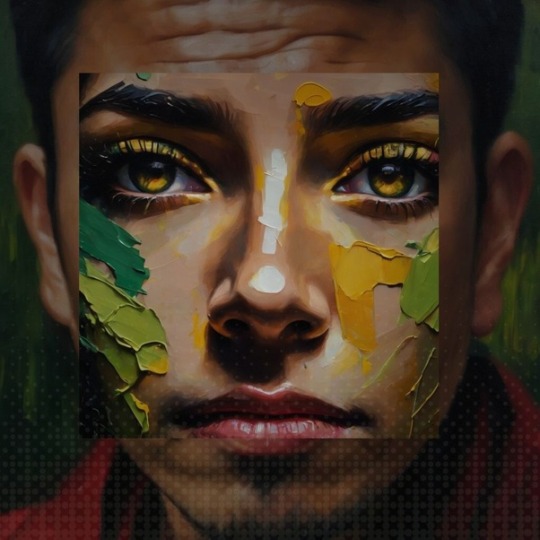
1. Innate Sensory Sensitivity:
Schizoid individuals often possess an inherent sensitivity to the barrage of stimuli in their physical and emotional environments. From a young age, this heightened sensitivity can lead to an overwhelming experience of sensory and emotional input, which can become so intense that the only viable response is to shut down emotionally. This protective mechanism serves to dampen the flood of stimuli. This heightened sensitivity can swiftly become overwhelming, compelling the individual to seek refuge in a state of emotional detachment as a means of self-preservation.
2. Defensive Emotional Barriers: As a response to over-stimulation, schizoid individuals develop psychological defenses, including emotional barriers that help them cope with their sensitivity. These defenses are vital in their infancy and childhood, serving as protective mechanisms against the barrage of external stimuli. However, these barriers also shield them from their own emotional experiences, creating a limited range of emotional expression and an inability to fully access or understand their emotions.
3. Social Misinterpretation: In social settings where expressive emotional responses are anticipated, schizoid individuals may find themselves unable to perform as expected. The societal expectation to express emotions in certain situations can be particularly challenging. Their lack of visible emotional response can lead to misinterpretations by others, who may assume indifference or a lack of empathy. This can lead to misconceptions by others that they are aloof, uncaring, or lack interest. The absence of expected reactions can perpetuate a negative cycle where the schizoid individual, in turn, receives negative responses from others, reinforcing their need for emotional defenses and further diminishing their affect.
4. Difficulty in Harnessing Aggression: An important aspect of the schizoid experience is the struggle with harnessing and expressing aggression. They tend not to retaliate even when provoked, except in circumstances of extreme duress. When confronted with hostility or aggression, they are less likely to respond in kind. This non-confrontational approach can unfortunately invite others to take advantage of their passivity, which may compound the need for emotional defenses and contributes to the loss of affect.
5. Cycle of Defense and Flat Affect: The ongoing pattern of needing to protect oneself from both internal and external emotional turmoil leads to increasingly fortified defenses. It is a protective measure, but one that unfortunately can lead to a self-perpetuating cycle: as their emotional expression diminishes, misunderstandings increase, leading to more negative interactions and a further need to shield themselves emotionally. Over time, these defenses contribute to a flattened affect, rendering the individual increasingly untouched by emotional highs and lows. This flat affect serves to protect the schizoid person from pain but at the steep price of also muting the experience of pleasure and connection.
In summary, through understanding these 5 reasons, we gain insight into the intricate mechanisms that contribute towards schizoid loss of affect. It is a complex interplay of innate characteristics, learned responses, and protective adaptations that converge to create the phenomenon of lost affect. Through this lens, we can cultivate empathy and offer a more supportive environment that acknowledges and respects the unique emotional landscape of those with schizoid tendencies.
Video From My YouTube Channel: Why Schizoids Lose Affect
#schizoid adaptaions#schizoid#schizoid dynamics#schizoid pd#schizoid personality disorder#schizoid vision#cluster a#loss of affect#flat affect
29 notes
·
View notes
Text
Moon Girl and Devil Dinosaur: Now That’s Moon Girl Magic!!!
One
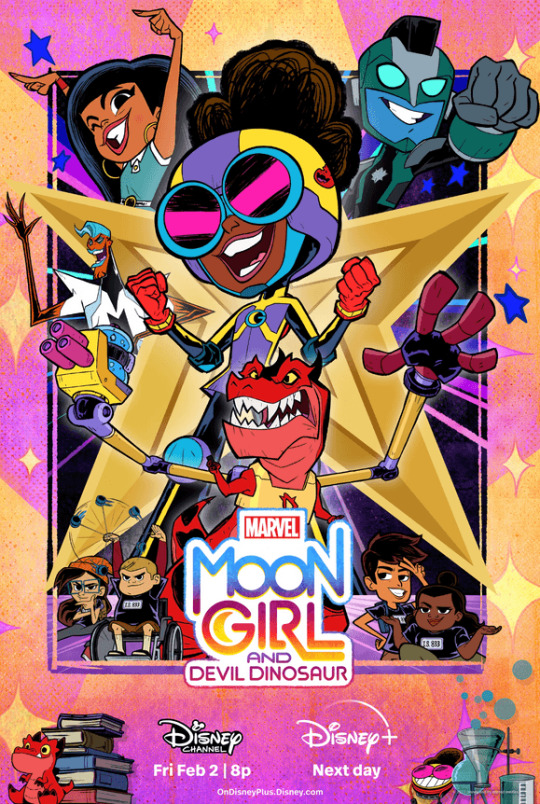
In my opinion, Marvel’s Moon Girl and Devil Dinosaur is one of the best new Disney shows in the 2020s and I’ll calmly make an argument for anyone who thinks otherwise. It has popping color, even poppier music, excellent characters, and strong storytelling all wrapped up in this fun, groundbreaking Disney show. With Season 2 coming out, I thought it was time to share what I got to say about its revolutionary ways and how it may even set the bar for future Marvel projects and even MCU ideas.
The Characters
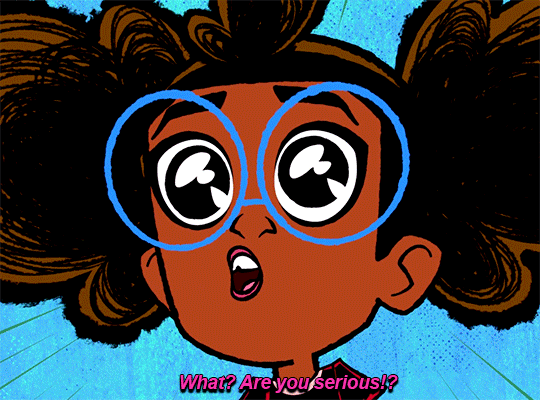
Lunella Lafayette, played by former X-Factor contestant Diamond White, is one of the most bombastic but relatable super-genius black girls at the time I write this. I love how her intelligence isn’t just her sole personality trait as she’s confident, sassy, and optimistic. Lunella is still a young teen who worries about fitting in, cares about her family, and tries to be the best person she can be.
I liked that they don’t make her into a bullied nerd like Peter Parker, which would contradict the whole message about protecting her community. She’s still pretty social around her fellow students but doesn’t have that social finesse which makes her have a lot of friends.
She’s a flawed character: she’s over-competitive and obsessed to the point of disregarding her work and other people. She does overcome and learn from those issues in order to become a better person in the end.
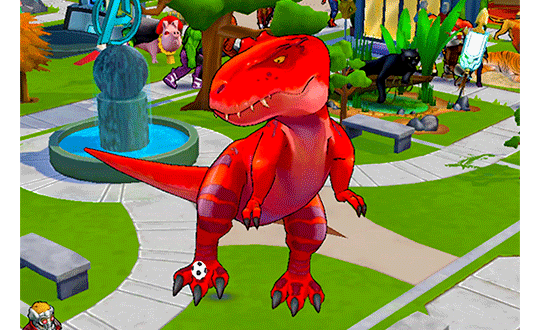
Devil Dinosaur is more than a pet sidekick meant to be cute or the comic-relief. He does get his time to shine from his insecurities of being too big to a fear of jellyfish. With basically growls and snarls made by Fred Tatasciore, Devil conveys a huge range of emotion from joy to sadness to anger.
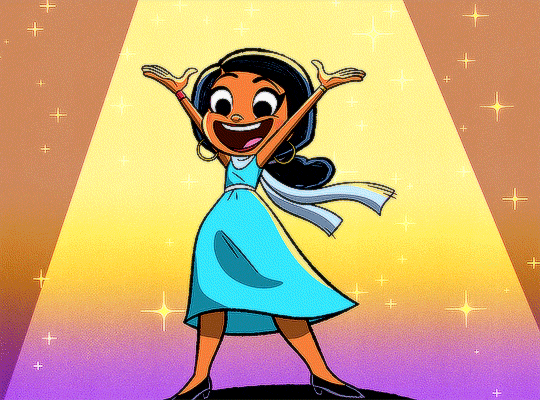
Casey Calderon is the best friend and manager of Lunella whose savvy with fashion and social media. She’s pretty much what you expect from the girl who’s into social media as exuberant and charismatic, but never shallow or vain. She genuinely wants to use her skills to help Lunella’s message spread. She’s the support to the superheroics of Moon Girl and Devil Dinosaur in making the heroes more human in the eyes of the LES.
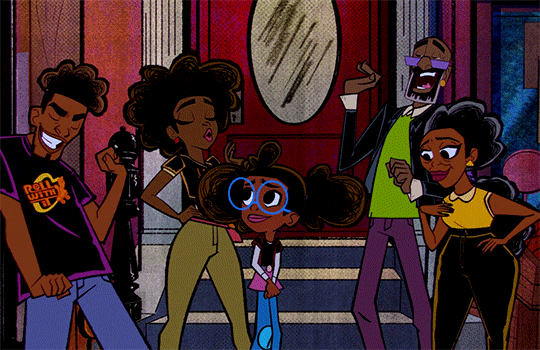
Many other characters have not only impacted the story but also the main cast itself with the Lafayette family and various members of the LES.
The Lafayettes have their times to shine in their own ways whether as shoulders for Lunella to get support from or voices of reason that plays into the lesson that she must face. Adria Lafayette acts as a strong moral compass for Lunella to follow like protecting the LES from gentrification. Both James Jr. and Pops aren’t as big as the Lafayette women, but they do get there times to shine throughout the show.
In the finales “O.M.G. Issue 1 and 2”, we get the reveal of Lunella’s grandmother Mimi, played by MCU alum Alfre Woodard, is the Original Moon Girl or O.M.G. who helped build the portal generator that Lunella rebuilt years later. It gives us a deep look into how the super-genius doesn’t fall far from the tree.
The Beyonder, voiced by the famous Laurence Fishburne, is a fun and interesting character that acts more of a reality warping nuisance to Lunella than an actual villain. Combined with Fishburne’s comedic delivery and stylish animation, the Beyonder is a hilarious trickster learning about humanity the best way he knows: messing with superheroes.
The Villains do create a dynamic with Moon Girl and Devil Dinosaur by creating various conflicts both externally, internally, even symbolically. The first villain of the show Aftershock was an electrical villain who literally stole power from the LES, putting businesses at risk of closing, which can be interpreted as someone taking away others’ autonomy from their homes. Another set of villains were the Muzzlers, basically high-powered tech giants wanting to gentrify the LES and take away anything unique from the people. They even “silenced” the people with their tech and rendered them voiceless, but the people prevailed together.
The show not only showcases obscure Marvel characters in new, refreshing ways, but also creates their own stellar ones that put together what it can showcase.
The Animation Style
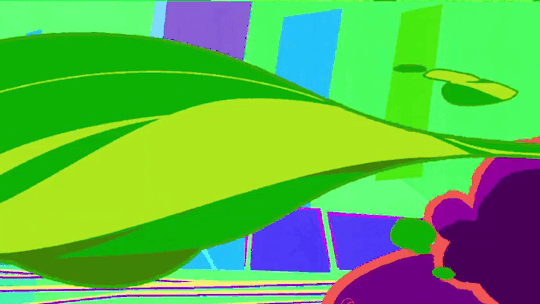
The most eye-popping way it stands out is the animation. The colors and style beautifully blends with the music. Every time a fight scene happens, the colors become much more vibrant with heart-pumping music from various artists. You can really tell that the animators put a lot of love and passion into making something both familiar but also standout with its fight scenes.
One of my favorite scenes is in Episode 3 “Run the Rink” with Moon Girl fighting Gravitas to a Childish Gambino song. A Childish Gambino Song! You know that you got a hit when you get a hit song from a famous rapper.
All the musical scenes play into the story in an entertaining way while fueling the animation on a higher level.
The Stories
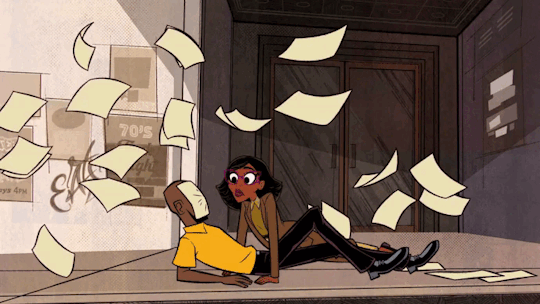
Almost every story plays into Lunella’s development throughout the first season from self-love and self-acceptance to fighting for one’s community. One of my favorite episodes is “Hair Today Gone Tomorrow” that perfectly addresses various issues about one’s hair. I think a lot of people, especially black women, can understand how we can get insecure about themselves. “O.M.G. Issue 1 and 2″ highlights how people of color, especially those in STEM fields, were essentially erased from the work they did and all credit was taken from them by the higher-ups. The main villain of the finales Maris Morlak is both a terrifying and relatable person whose motivations are sympathetic in how his work was taken from him and was erased.
What’s Next For Moon Girl?
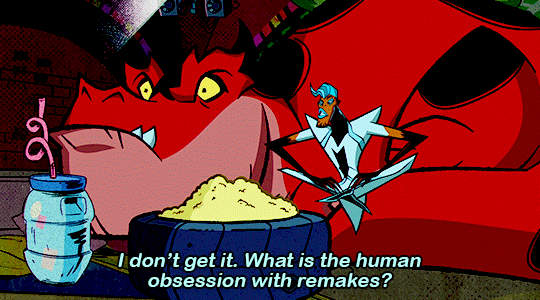
With Season 2 coming out of woodworks, I’m hoping to see more adventures, heart, and fly music that elevates Moon Girl to a different level and even set more bars in terms of storytelling and animation for both Marvel projects and even the MCU itself.
#moon girl spoilers#moon girl and devil dinosaur#mgadd season 1#mgadd spoilers#lunella lafayette#devil dinosaur#casey calderon#mimi lafayette#diamond white#fred tatasciore#alfre woodard#mgadd season 2#libe barer#Marvel MCU#marvel#MCU#women in stem#childish gambino#laurence fishburne#aftershock#maris morlak#villains
18 notes
·
View notes
Text
The Charm of Pencil Rendering: A Guide for Students Studying Multimedia
Pencil rendering is still an effective and expressive technique that links us to centuries of artistic history in an age where digital art and technology rule the art world. Learning pencil rendering as a multimedia student can help you become more creatively flexible and have a deeper understanding of artistic fundamentals. Precise control, depth, and texture are made possible by pencil rendering, which is timeless and essential to all artistic mediums. This tutorial will assist you in starting your adventure into the world of pencil art, regardless of your level of experience or desire to improve your abilities.

Understanding how to Render with Pencils
Pencil rendering is the process of producing artwork with depth, shading, and textures using colored pencils, graphite, or charcoal. Pencil rendering uses manual methods that call for patience and control, in contrast to digital art, which is created on a computer. The subtle tone changes, delicate lines, and the depth created by layering and shading are what make this art form captivating.
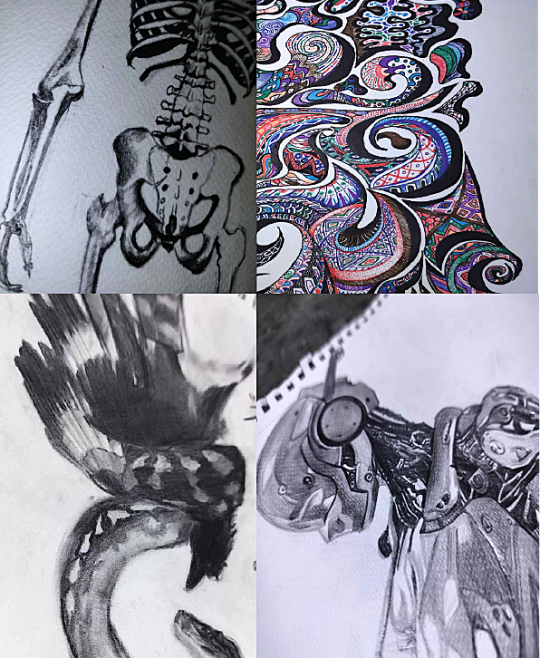
Key Tools to Begin
Sketchbook and Paper: Select high-quality paper with the appropriate texture (rough for improved graphite adherence, smooth for fine details). For a variety of shading effects, graphite pencils come in grades ranging from harsh (H) to soft (B). Charcoal Pencils: Perfect for expressive strokes and deep, rich blacks. Blending Tools: To even out shading, use cotton swabs, tissues, or stumps. Erasers: Precision erasers for fine details and kneaded erasers for delicate accents. For intricate work, use sharpeners and mechanical pencils ( optional for mechanical pencils ) to guarantee precise lines and constant sharpness.
Crucial Techniques to Learn
Sketching and Line Work: Learn to manipulate your lines by starting with basic forms. Shading and Blending: To add depth and texture, use master hatching, cross-hatching, stippling, and smooth shading. Light and Shadow: To produce realistic drawings, comprehend how light interacts with surfaces. Composition and Perspective: To create more dynamic artwork, learn about depth, symmetry, and balance. Texturing and Layering: To create representations that are richer and more realistic, gradually add layers.

Connecting Digital Art and Pencil Rendering
You can use your understanding of pencil rendering as a solid basis for digital design, animation, and other multimedia projects as a multimedia student. Hand-eye coordination is improved, contrast and form are better understood, and creativity that may be transferred to digital platforms is fostered by practicing conventional approaches. Consider taking a picture of your pencil work or scanning it, then utilizing programs like Photoshop or Illustrator to enhance it digitally.
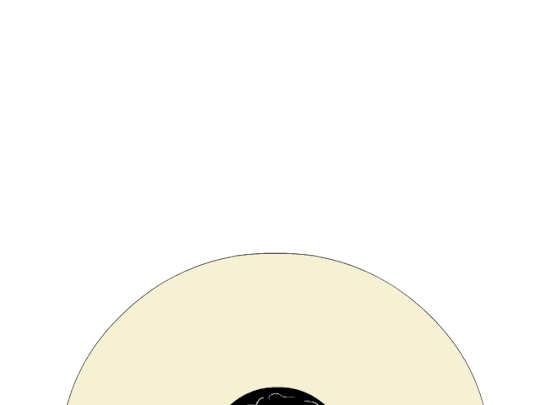
Getting Inspired and Creating Your Own Style
Finding your own style is one of the most thrilling parts of pencil rendering. Begin by studying the pencil works of famous painters such as Albrecht Dürer, Leonardo da Vinci, and contemporary masters of graphite. Try a variety of shading methods and subjects to find what appeals to you. Still life drawings, architectural sketches, portraits, and nature can all be excellent sources of inspiration.
The secret to improvement is patience and practice.
Pencil rendering requires commitment and time to learn, just like any other ability. Make time for consistent practice sessions, push yourself with novel approaches, and don't be scared to make mistakes—they're a necessary part of learning. You can grow more quickly by participating in art communities, attending workshops, and asking for helpful criticism.

In conclusion A fun and engaging technique that lets you convey your ideas with accuracy and depth is pencil rendering. Incorporating pencil rendering to your workflow as a multimedia student can enhance your digital creations and expand your creative horizons. The process of using pencils to create art is just as rewarding as the finished product, whether you are sketching, shading, or experimenting with mixed media. Grab your pencils, enjoy the process, and unleash your inner artist!
2 notes
·
View notes
Text
Grid-Based Movement in Board Games
Game 1 - Chess
youtube
Chess is a game that needs very little explanation. Two players control sixteen pieces, with the aim being to capture the enemy king or cornering it so it cannot move without being captured (in check). Different pieces have different movement and capture rules - pawns, for example, can only move forward, and they can only capture pieces diagonally in front of them. However, if a pawn gets to the end of the board, they can become a more powerful piece, and will then usually be in a strategic location near the enemy king. Rooks can move vertically and horizontally, but have infinite movement range on the board. Bishops are the same, but they move diagonally across tiles. Knights move in an L-shape, but carry the ability to leap over pieces. The queen is the most powerful piece, since it can move in all eight directions with infinite range. The king can also move octagonally, but only one tile at a time. While this is seemingly simple, chess has a very high skill ceiling, and the basic movement rules can be pushed in interesting ways like en passant.
Game 2 - Hive
youtube
Hive is a game that I would describe as "Chess but easier, and with bugs." Two players each start with a queen bee tile, and the aim is to completely surround the opponent's queen bee with other hexagonal tiles. There is no real capturing of pieces like chess - once a piece can no longer be moved, it stays on the play area and almost becomes part of the board. Because the pieces are hexagonal, they can move in six directions, but area denial is a key tactical factor - a piece cannot move if it would split the Hive into two, so pieces can be trapped at chokepoints and be rendered unusable. Each piece has a unique move rule; the queen bee only moves one tile, the spider can move three, the grasshopper leaps over tiles in a straight line, the soldier ant can move an unlimited distance but only adjacent to other tiles, and the beetle can climb on top of tiles and pin them. I think this game does a few things better than chess - in the late game of chess, the board becomes depopulated and sparse, but in the late game of Hive, the board becomes larger and far more complex, with all the pieces being possibly able to move. It's quite dynamic.
Game 3 - Checkers
youtube
Checkers is a relatively simple game, played on a chess-like grid, but with simpler pieces. They can move forward one tile, but to capture an opposing piece, they can leap over it and to the tile on the other side. Captures can be directly forward, or diagonal like a pawn, but all pieces act the same. The grid based movement acts, as it does with most of the other games, as an equalizer, keeping each move the same distance on the board and thus giving each player only the advantage of their tactical thinking.
Game 4 - Snakes and Ladders
youtube
This is a classic board game, where two players move their counters up a numbered board. The number of spaces they move is determined by a dice roll usually, and if they land on a snake tile, they slide down to wherever the snake ends on the board. Likewise, if they land on a ladder tile, they can climb up to wherever the ladder leads up to. While the game is not too tactically interesting, given that it is all up to chance, I do like the way that the game handles the grid. It is designed to be somewhat interpreted as a vertical space, and the snakes/ladders allow you to travel on another plane parallel to that.
Conclusion
As I spoke about a little before, grids are a way of making movement precise on a given board. Some games, like Warhammer, instead have incramental movement in any direction, but require you to measure the distance a given piece will move using a ruler. Grid-based movement simplifies this, and allows for more innovation in different ways that pieces may move relative to the grid, such as moving diagonally, or taking extra steps. Now I will look at games that use this system, and see if they do it for their own reasons.
2 notes
·
View notes
Text

High-Quality Tiger Art Image Ready to Print - Digital Download
This stunning digital download features a highly detailed, high-resolution tiger image, meticulously crafted to deliver vibrant colors, sharp lines, and lifelike textures. Perfect for print, this image is designed to maintain exceptional quality even at larger sizes, making it ideal for home decor, office spaces, or any creative project that requires an impactful and striking visual.
The tiger, captured in all its majestic glory, stands out with a dynamic and natural pose, showcasing the powerful grace and beauty of this magnificent animal. Every strand of fur is rendered with precision, from the intricate patterns on its coat to the intensity in its piercing eyes. The background complements the tiger, providing a harmonious balance of color and contrast, without distracting from the animal itself.
Whether you're planning to print it on canvas, poster paper, or any other medium, this image offers the flexibility and high resolution necessary for producing professional-quality prints. With a file that ensures crisp detail and rich color depth, this high-definition tiger image is ready for immediate download, allowing you to create the perfect print piece at your convenience.
Features:
- High-resolution image for superior print quality
- Perfect for large-scale prints or framing
- Lifelike details and vibrant colors
- Instant digital download for immediate use
- Versatile for a range of print mediums (canvas, posters, etc.)
- Ideal for home decor, office, or nature-themed projects
Bring the raw beauty and power of the tiger into your space with this premium-quality digital download, ready to be printed and displayed for all to admire.
Please note: This is a digital product, and no physical items will be shipped. Print colors may vary slightly depending on your printer and paper type.
Get it now
#tiger#digital art#digital illustration#digital drawing#digital download#frame#frames#artwork#art#drawing#print#printable
2 notes
·
View notes